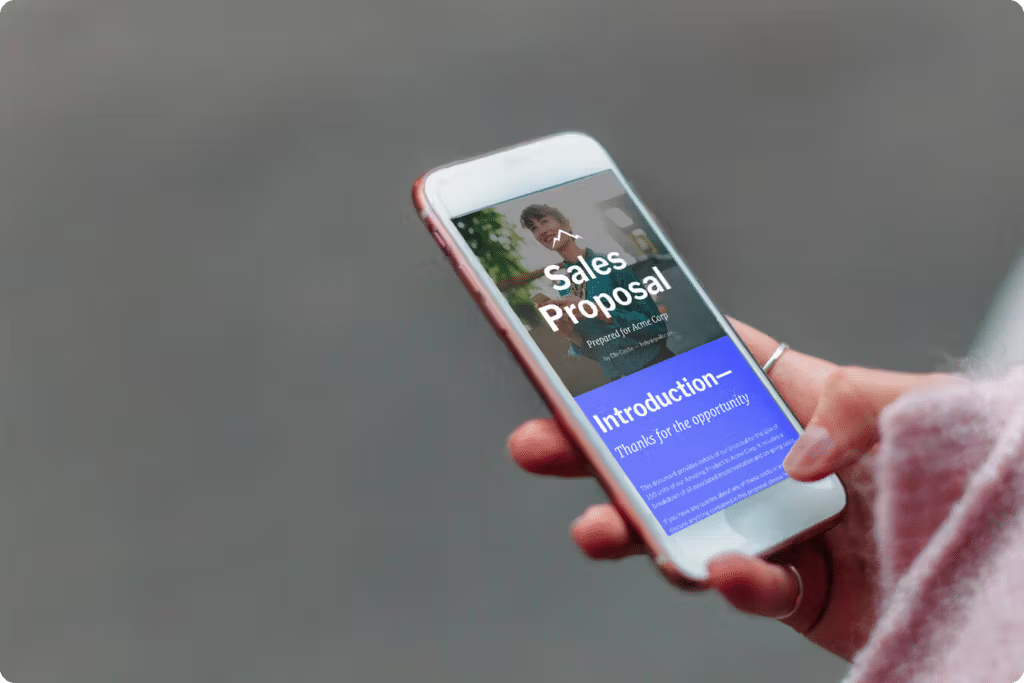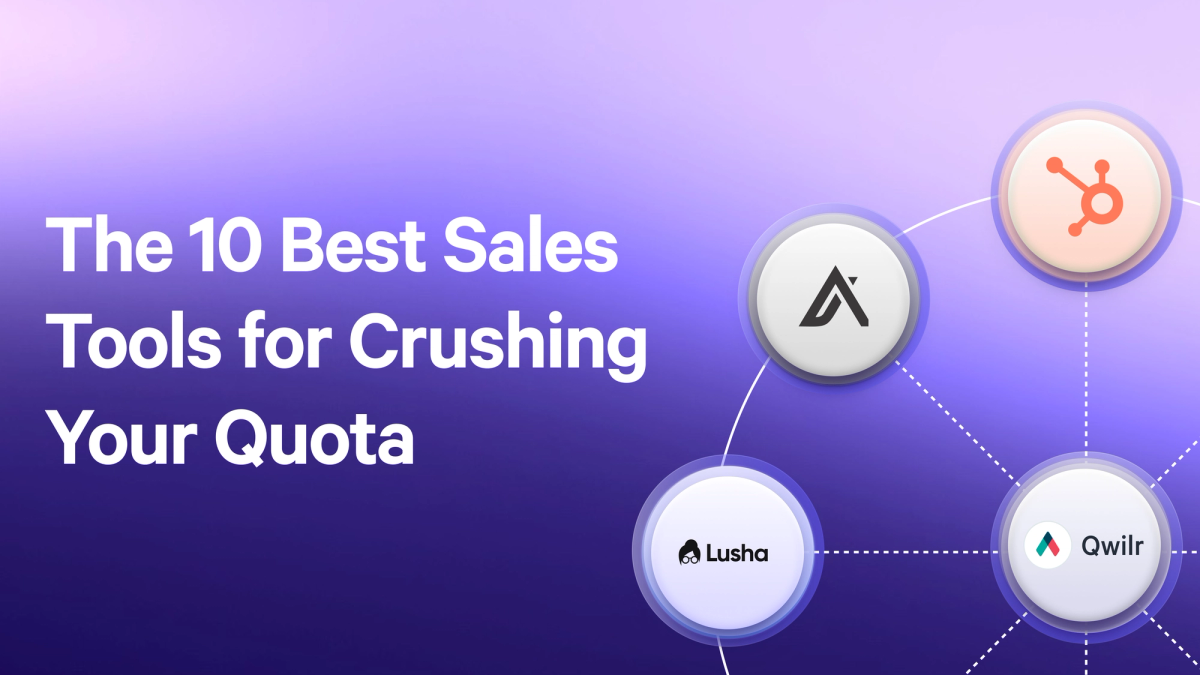Establishing a consistent sales process can be challenging. However, it becomes even more daunting when reps are tasked with meeting their quotas while simultaneously managing numerous low-value, manual administrative tasks.
Solution? Sales automation.
Automation is the only way to optimize your sales process and close more deals, without increasing the headcount.
Whether you’re looking to level up your sales strategy with automation, or you’re currently in the process of building your sales process from scratch, you’ll find the info you need to implement effective sales automation in this guide.
What is sales automation?
Sales automation involves incorporating technology into your sales process to eliminate manual work and increase sales efficiency. It may apply to any stage of the sales cycle, from prospecting and lead scoring to closing sales deals and upselling.
Most modern sales automation software, be it a CRM system, email marketing software, or a proposal management platform, offer some level of automation as part of its functionality. Therefore, you generally don’t need technical knowledge to set up your first sales automation workflows.
Why implement sales automation
Almost one-third of sales professionals’ primary goal this year is to make their sales process more productive. And sales automation is one of the best ways to capture that increase in productivity. Here’s how automation contributes to improving your sales efficiency.
1. Automation gives you control over the sales process
If you’re struggling to build and adopt a consistent sales framework, automation is right for you.
When automating the sales process, you also standardize it. From now on, technology will be performing repetitive tasks, without deviating from the flows you’ve carefully pre-built.
2. Automation increases sales productivity
Automation eliminates manual, time-consuming work, allowing sales teams to successfully complete more high-value activities during the workday. Most importantly, automation helps to prevent employee burnout by reducing the workload on sales reps.
3. Automation aligns marketing and sales
Making marketing and sales teams work together is critical, but it’s also extremely difficult when you don’t have the right tools at your disposal. Automation solutions increase marketing and sales alignment by giving both teams more visibility into the customer journey.
To enable automation, you need to centralize the data from multiple sources to use it in your workflows — the byproduct of this is of course that both teams gain a shared view of the marketing and sales processes.
Also, automation unlocks new opportunities like lead-scoring to ensure your sales team only receives qualified leads from marketing campaigns, which is key to marketing and sales alignment.
4. Automation creates a better customer experience
Automation is all about data. By constantly collecting and analyzing insights into your customer behaviors, sales automation tools give you a better idea of your prospects’ and customers’ preferences. Thus, you can tailor your messaging and content to the individual needs and interests of each customer.
Furthermore, automation allows you to deliver more timely communication than a sales manager working 9 to 5 shifts can. You can set up triggered email sequences, provide 24/7 support through a chatbot, and/or offer an easy way to schedule phone calls with your reps via automated workflows. No long response times and frustrating experiences.
5. Automation boosts conversion rates
All the aforementioned outcomes of sales automation including a consistent sales process, engaged sales reps, cross-alignment, and personalized emails undoubtedly have a positive impact on your sales funnel.
Automation eliminates the friction from the sales process and speeds up the entire buyer’s journey, increasing sales uplift potential by up to 10%.
6. Automation can help increase customer lifetime value (CLV)
The longer your customers stay with you, the higher their value is to your business. Introducing automation ‘beyond the sale’ is a great way to further nurture relationships with existing customers, spot early churn signals, and pursue upsell opportunities.
How to implement sales automation in a small business
Due to the variety of technology solutions available in the market, implementing sales automation is no rocket science. You just need a plan and some patience. It can take up to six months to see the impact of your implementation efforts, and the wait is definitely worth the results.
As for the plan, here’s the one you can stick to:
1. Identify areas requiring automation
To identify automation opportunities, break your sales process down into the different funnel stages. Here’s how it may look:
- Preparation
- Prospecting
- Approach
- Presentation
- Handling Objections
- Closing
- Negotiation and follow up
Your sales process may vary based on your go-to-market strategy or industry.
Each of these stages represents opportunities where sales automation could be applied to drive better outcomes.
For instance, prospecting typically involves sourcing contact data and mapping out larger accounts if you run an enterprise sales motion. There are numerous tools that can be used to automate parts of this process, and we’re increasingly seeing new solutions enter the market that are geo-specific or industry-specific.
To uncover what areas require automation, it’s helpful to go broad in your initial search, and then go deep on prioritization to ensure you’re being effective with resources.
Remember, it’s important to speak to the end users, your sales reps, and leaders. Be sure to speak with reps, leaders, and adjacent functions like Customer Success and Channel Partnerships to understand how their workflow looks today and what could be improved - this will avoid time-wasting initiatives that don’t actually solve real day-to-day problems.
When thinking about prioritization across your sales process, a few steps to take are:
- Identify pain points in your current sales process. Where is your sales team underperforming?
- Determine the potential impact of automating different tasks. How much time can you save with automation?
- Estimate the cost of implementing automation. How much time and money can you affordable to spend implementing workflows and training your team on them?
- Prioritize based on impact and feasibility. What are the most time-consuming tasks in your teams’ routines? Which tasks are the easiest to automate?
2. Check your current CRM system’s automation features
Once you have identified the areas that require automation, the next step is to evaluate the capabilities of your current toolkit (if you’ve been running sales activities up until this moment).
You’re likely to have a CRM system or an email marketing platform where you store your contacts’ data and manage customer communications.
Now, you need to check your toolkit’s automation features. Are there any? Here are a few features to look out for:
- Lead management — you should be able to capture and manage leads from various sources, including your website, social media, and email campaigns. Your sales automation platform should have a lead scoring system that allows you to prioritize leads based on their potential to convert into customers.
- Email automation — a good automation platform should offer sales email templates, scheduling, and tracking capabilities.
- Sales pipeline management — your sales system should automatically track all your sales opportunities, detect any changes, and sort them depending on certain criteria, such as lead score, stage in the sales cycle, and/or size of the deal.
- Sales forecasting — look for sales forecasting features, such as predictive analytics and historical data analysis, to make better decisions about resource allocation and budgeting.
- Proposal management — creating and delivering sales materials automatically will not only save your time but also create a consistent image for your brand and increase deal velocity.
- Integration capabilities — make sure your sales data can flow within tools in your tech stack without roadblocks. You should be able to connect your sales software with the help of native integrations, Zapier, or API integrations.
Make a list of capabilities your current tech stack currently can cover and can’t cover. Then you may find it helpful to think about which of these capabilities are ‘nice to have’ vs ‘must have’. Depending on how satisfied you are with your sales tech stack, you may look at complementary tech solutions before you undergo a full ‘rip and replace’.
3. Add the necessary technology to your tech stack and integrate it
With the abundance of solutions available in the market, it's important to choose the ones that fit your specific business needs.
One aspect you should pay particular attention to is scalability. The technology you choose should be scalable to accommodate your business growth without breaking the bank.
There are plenty of sales automation tools that offer freemium plans or cheap paid packages, but once you need to upgrade, the costs get unreasonable. Make sure to anticipate your growth when choosing automation software so that you don’t have to switch to a different solution after so much work.
Once you’ve chosen the right tools (check out our recommendations in the next section), create a centralized hub where all the data flows in and where your sales reps can find it easily. For instance, if you use LinkedIn Sales Navigator for prospecting, Google Ads for lead generation, Qwilr for proposal automation, and Drift for customer communications, you can sync the relevant data properties to a CRM like HubSpot or Sales, and start to create a more complete picture of the customer journey.
4. Build automated workflows, step-by-step
Finally, you begin your automation journey. Just don’t rush and take a phased approach.
As you build each workflow, be sure to test it thoroughly to ensure that it works as expected. You may need to make adjustments along the way to optimize the workflow for maximum efficiency.
5. Drive digital adoption in your sales team
Sales process automation is a big change for everyone involved. If your team is used to manual processes, the transformation may be painful.
To root the new workflows in organizational procedures, you need to offer technology training.
Provide your sales team with adequate training and support to help them adopt new workflows. Host digital adoption workshops, provide in-app guidance, and create comprehensive documentation to answer all the possible questions about automation technology and empower your team to get the maximum value of it.
The best sales automation tools
Let’s finally go through the list of tools that will help you implement sales automation smoothly.
Best in all-in-one CRM: HubSpot
Haven’t implemented a CRM system yet? An all-in-one solution like HubSpot is the best place to start.
HubSpot combines all the ‘must-have’ automation capabilities in one interface, allowing you to focus on optimizing your sales process instead of constantly switching between tools.
The company offers a range of products such as Marketing Hub, Sales Hub, and CRM Suite to name a few. We recommend that you go for HubSpot CRM Suite to access the most essential marketing, sales, and CRM features in one package. From lead capture forms and email marketing automation to lead scoring and sales operation automation, HubSpot CRM has got it covered.
The biggest benefits of HubSpot are intuitiveness, a well-built integration ecosystem, and an abundance of learning materials that help you make the most of the platform.
The drawbacks? Once you need to go beyond essential functionality, the platform’s price jumps to almost $1,600/month for their Professional plan. Therefore, you should examine the limits of HubSpot plans before committing.
Best for proposal management: Qwilr
Perhaps the only thing you can’t do in HubSpot is manage proposals effectively. Qwilr can handle it for you though.
Qwilr offers a proposal automation and content management solution. With Qwilr, you can generate sales quotes, pitch decks, digital sales rooms and more within minutes. Interactive quotes, embedded e-signature, rich-media re-usable content, instant payments — these are just a few features of Qwilr that make sales reps’ lives easier.
Best of all, you can integrate Qwilr with HubSpot (or your chosen CRM system) and manage your proposals from there. You can dynamically personalize every proposal by pulling in customer data from your CRM platform.
Best for meeting management: Calendly
A comprehensive CRM system like HubSpot offers built-in meeting scheduling functionality, but there are a lot of platforms that don’t. So if you use one of these, Calendly will help you book sales calls frictionless.
Calendly is a meeting scheduling tool that acts as your assistant — all you have to do is share the Calendly link with your potential customers so that they can choose the time slot that works for both of you. The tool also facilitates the sending of automated reminders and post-meeting follow-up emails.
Best for prospecting: Apollo.io
While CRM systems can serve as lead management tools if they possess the required features, dedicated software for prospecting and lead management is often more effective. In this regard, Apollo.io is an excellent choice.
Apollo.io is a sales intelligence platform designed specifically for B2B companies. It generates B2B leads based on specified criteria and seamlessly integrates lead data into your sales process within your CRM. Apollo.io's extensive database of B2B companies allows you to create comprehensive lead profiles, enhancing your prospecting efforts.
You can manage your leads directly from the Apollo.io interface or integrate the platform with your existing CRM system. Apollo.io is compatible with major CRM software, including HubSpot, Pipedrive, Salesforce, and others, ensuring a smooth integration process.
Frequently asked questions
How does sales automation benefit sales teams?
Sales automation allows sales teams to spend less time handling manual tasks and focus on high-value activities.
How can you get started with automating sales tasks?
To get started with automating sales tasks, you need the right technology and a clear implementation plan. Start by identifying the tasks that affect your sales process the most and then implement new automated workflows step-by-step.
What is an example of sales automation?
An example of sales automation is using lead management technology to capture new leads, store lead data, and then score those leads based on the pre-defined criteria — all automatically of course (or with as little necessary human input as possible).
Start saving time today
Sales automation is a must for every business, big or small. Whether you have one person on your sales team or multiple sales teams spread across many regions, automation will help you build a more consistent, and scalable, sales process and reach new revenue targets.
As you start to explore ways to optimize your sales efforts, don’t forget to use automation to streamline your proposal management process. Qwilr will help you create customized, professional-looking proposals in minutes. Plus, get a better understanding of your sales effectiveness with analytics. Sign up now to start transforming your sales process.
About the author

Brendan Connaughton|Head of Growth Marketing
Brendan heads up growth marketing and demand generation at Qwilr, overseeing performance marketing, SEO, and lifecycle initiatives. Brendan has been instrumental in developing go-to-market functions for a number of high-growth startups and challenger brands.


